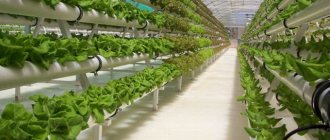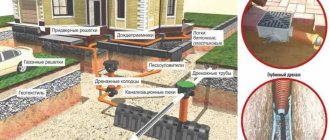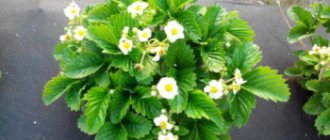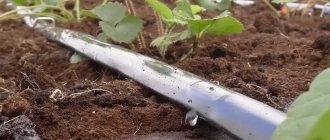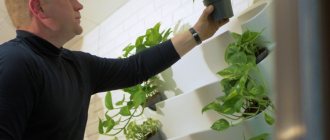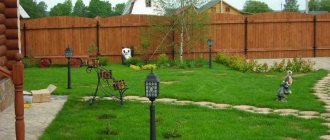Aeroponics is a method of growing plants without soil and can be considered a branch of hydroponics. The essence of the method is that the roots of the plant remain in the air and are periodically irrigated with a nutrient solution using special nozzles.
Making a small aeroponic setup at home is not that difficult. As an experiment, we will consider two types of such an installation: an installation with a water pump and an air compressor.
Aeroponics industrial equipment – what is it?
Industrial equipment for air growing is a system of various elements. They allow you to cultivate plants without soil and immersion of roots in nutrient liquid:
- The plant is in the air. It receives a sufficient amount of oxygen, and when the aerosol is sprayed, the roots receive nutrition.
- Industrial scale requires high power of the equipment used (compressors, pumps, pumps).
- A large space is also needed to accommodate the equipment and the crops themselves.
- Vertical placement is often used. This allows you to optimize space and use it rationally;
- At home, you can also use some elements of ready-made systems or assemble them yourself.
A little history
The first experiments on cultivating plants in the air were carried out in 1911 by Professor V.M. Artsikhovsky, it was he who first assembled a prototype of aeroponic equipment. And in 1957, the American scientist F.W. Vent developed and tested a technology for growing plants without a soil layer, calling it aeroponics. The first universal aeroponic equipment was developed by Russian scientist Yuri Tsaturovich Martirosyan. The device, called "Harvest-9000", was used for cultivating various agricultural plants.
Advantages and disadvantages
Aeroponics, like all other growing methods, has a number of advantages and disadvantages.
Pros:
- The roots receive the maximum amount of oxygen. Growth is accelerated and the harvest period is shortened.
- An optimal environment for culture is created. Thanks to this, the yield increases significantly compared to the conventional growing method.
- The aerosol contains all the substances necessary for the plant. This process can be controlled.
- It is easy to solve a plant pest problem.
- Optimal use of space. Possibility of placement in several tiers.
- Easy system maintenance. To replace plants or in preparation for a new season, you just need to remove the old crops and clean the irrigation system.
Minuses:
- It is necessary to constantly monitor the composition of the solution and the presence of a sufficient amount of nutrients in it.
- Maintaining the automated system in working order. It is necessary to quickly eliminate breakdowns and timely reconstruction.
- High requirements for hygiene conditions of the root system.
Nutrient solution
Here I also spent a long time studying alternatives. I thought about ready-made solutions and about making them myself. In the end, I decided to take a risk: first I made a mixture of fertilizers, but everything turned out so inconvenient, complicated and with an uncertain result that I found a chemical supplier. reagents, bought pure substances and gradually arrived at the current three-component concentrated composition. Unfortunately, I don’t know how good it is: I would like to do a foliage analysis to check what is missing/missing, but I don’t yet understand where and how to do this. Several times I almost killed the bushes with my suboptimal composition and incorrect acidity, but nothing happened.
I mix the solution itself using distilled water, which I buy. To be sure of the composition, the solution is not reused; the drain is immediately disposed of. By the way, since this is aeroponics, I use a solution with an EC around 400 mS/cm3 (TDS - ~200 ppm on a 0.5 scale). Moreover, there is a suspicion that this is too much. For comparison, the TDS of my tap water is about 130 ppm.
What is the difference between aeroponics and hydroponics?
The main differences between these two cultivation methods are the following:
- The hydroponic system involves placing the root system in an aqueous solution of nutrients. With aeroponics, plants are completely in the air. They receive nutrition by spraying an aerosol on the roots.
- Aeroponics provides absolute environmental safety for the crops grown;
- Unlike hydroponics, using this method does not carry the risk of algae. They appear in containers with a nutrient solution, also in containers with roots;
- Aeroponics provides a rich supply of oxygen, which has a beneficial effect on growth and productivity.
Conclusion
Aeroponics may well become an effective alternative method for growing plants on an industrial scale, especially in regions with poor soils.
For small farms or home use, aeroponics has already proven itself as an effective way to grow herbs and vegetables with the possibility of year-round harvesting at low cost.
Sources:
https://www.ogorod.ru/ru/main/tekno/8840/Aeroponica-%E2%80%93-poluchaem-urozhaj-pryamo-iz-vozdukha.htm https://rozarii.ru/inzhenernye-sistemy/ izgotavlivaem-samodelnuyu-aeroponiku.html https://xn--e1aelkciia2b7d.xn--p1ai/stati/rastenievodstvo/ayeroponika-ili-vyraschivanie-na-vozduhe.html
How to assemble equipment with your own hands: technology and necessary materials
On sale you can find any individual elements or ready-made completely aeroponic systems. But, if desired, you can assemble such an installation yourself. In order to assemble equipment for aeroponics with your own hands you need:
- Containers or reservoirs for nutrient solution and grown crops.
They should close tightly and be opaque. The sizes depend on how many plants are planned to be placed in them.
- Elements for supplying aerosol from the container to the root system. These could be tubes, hoses, nozzles .
All these components can be found on sale without difficulty. They should also be opaque. Particular attention should be paid to the nozzles, or more precisely to the nozzle. This will allow you to irrigate with droplets of the desired size. Additionally, you can purchase silicone to ensure the tightness of the finished system.
- Pump, pump, compressor and timer. These elements come in different types and differ in their power. The choice directly depends on the scale of cultivation.
For a simple and small irrigation system, you can even use a windshield wiper pump in a car. If there are 2-3 or more sprayers, it is recommended to purchase a more powerful pump. When choosing an air compressor, the main criterion is its pressure. It must be at least 1 atmosphere.
You can also use a car compressor. It is advisable to choose one that automatically turns off when the maximum pressure is reached.
- The pump and timer are attached to a reservoir containing liquid. There are nozzles at the bottom. The hose is used to connect the injectors and the pump. Next, the plants are planted and the tank is filled with solution.
The design is ready for use. To seal it, it is recommended to use silicone.
Assembly
So, I spent a couple of months figuring out what I needed to build the system and ordering the components. For nozzles, I decided to try using Chinese nozzles from AliExpress. I also ordered pressure regulators, solenoids and a bunch of electronics there.
The assembly process is a separate story, full of unprintable expressions, so I’ll just put a few photos in the spoiler. This was all purchased at Leroy Merlin, with the exception of the film, which was presented to me by a friend. Based on the experience gained, I would not go this route and in the near future I will remake the container for the roots.
Photos of the installation production process. A LOT of photos.
PBusyboard for adults
First version
I then made a short video with a superficial overview, and since I communicated on American forums, the voice acting there was in poor English.
The first version involved a main inlet pressure reducer along with an air filter and a drying device, two precision pressure reducers from 0 to 2 bar (at that time I believed that I could get by with pressures up to 1 bar), two 12V solenoids controlled by a controller on the base esp32, as well as one nozzle.
At that time, I had already received the electronics and even wrote test firmware to test my idea with an external control panel and a microcontroller that was supposed to communicate with the panel via the MQTT protocol, about which I also made a video (again, in bad English, and watch it is needed at a speed of at least x1.5).
By the way, I did not mention one more component - light. Light is a very important thing. I would say the most important or one of the most important. I ordered the light on Alibaba; Unfortunately, this offer is no longer available, but it is an LED lamp with adjustable power up to 240W using Samsung lm301b full spectrum diodes with a temperature of 3000K with the addition of several LEDs with a wavelength of 660 nm. It shines very brightly.
A little about Light (crossed out) about light
In addition, we had to solder and assemble some electronics in the process. A few details on the topic below, but for now one of the controllers is in the process of testing.
Types of Aeroponic System
Aeroponics systems can be of several types. They are divided depending on the way in which the liquid for feeding the roots is converted into an aerosol:
High pressure pump system
Provides spraying of roots at certain intervals. This type of system has the following characteristics:
- The upper part of the culture is on the racks.
- The root system of the plant is located in a special sealed space. A sprayer is directed into this part, which on the other side is connected to the pump. The pump pumps the prepared solution from a special tank.
- Root nutrition occurs automatically at regular intervals. For seedlings, the intervals are short: 5-10 minutes. For adult plants, they are increased to 20 minutes. Untimely supply of nutrients is detrimental to any plants.
- The nutrient solution is converted into a “fog” of tiny particles. It envelops the root system, nourishing it and saturating it with necessary substances.
- The rest of the time, the root system is in the air, receiving the maximum amount of oxygen.
Aeroponic system with air compressor
It works like this:
- The solution is placed in a special tank;
- Air is supplied to the tank using a compressor;
- During this process pressure is generated. It lifts liquid through the tube. When the fluid reaches the solenoid valve, it opens under pressure;
- The solution reaches the roots through the nozzle.
Ultrasonic aeroponics
The principle of its operation is similar to climate control units:
- Ultrasonic waves pass through the solution;
- This process leads to the appearance of cavitation bubbles;
- The solution is sprayed in the form of tiny particles.
Important! The mist obtained using ultrasonic aeroponics has a too high temperature of 40 C. While crops require a temperature of no more than 20 C. For this reason, it is necessary to pre-cool the liquid.
Due to its features, this method is good for growing seedlings or young greens.
How to prepare an aerosol for aeroponics
An aerosol is water in which all the nutrients the plant needs are dissolved:
- There are various formulations of such compositions, depending on the plant itself and its needs.
- The volume of dissolved substances and the frequency of their intake must be regulated. They often have to be changed throughout the plant's growth. Because the needs of the culture may change along the way.
- At the moment of spraying, fine particles settle. The moisture evaporates and the concentration of the contained substances increases. Analysis of plant growth and development will help you choose the optimal regime.
- The main composition in the aerosol is: potassium, phosphorus and nitrogen. In addition to them, they also add: calcium salts, citrates, iron, zinc, magnesium and copper sulfate. All components are applied in a form suitable for acceptance by the root system.
- To store salts, prepare a dark, dry place and sealed containers.
- Salt solutions are prepared separately and then mixed.
- Water should not contain foreign impurities. For this reason, distilled or settled water is used rather than tap water.
- Hard water is softened using filters or tablets. Sometimes they settle with the addition of peat for about 12 hours (70 g of peat per 1 liter of water).
Also learn how to make a hydroponic system for growing strawberries and the features of this method.
For which plants coconut substrate is used, and why we will better explain it in the next topic.
How to choose a lamp for indoor flowers: .
Ready-made hydroponic fertilizers
What to choose? Ready-made mixtures or try to make your own? For beginners who do not have enough experience in calculating the amount of fertilizers, it is better to start with store-bought ones to see how the plants look in balanced formulations. In case of failure with self-production, it will be possible to urgently correct the situation.
As experts in hydroponic systems say, hydroponics does not forgive mistakes. Because with this method of nutrition, the nutrient liquid immediately reaches the root system.
If it is concentrated, it will destroy the roots in an hour. After all, there is no soil here that would take on part of the chemistry. Therefore, it is necessary to count, count and count again.
The prepared liquid or dry substance for plant nutrition only needs to be diluted with the required amount of water. There is no need to add anything - everything is provided by the manufacturer.
The market offers many ready-made hydroponic fertilizers
More experienced plant growers know how much of what is needed and in what period. In addition, the nutritional needs of each crop are different. Some need more potassium, others magnesium, and others need nitrogen, as they are indoor decorative ficus plants, for example.
Ready-made nutrient solutions include:
- nitrogen for gaining green mass;
- potassium for fruit ripening;
- phosphorus for root formation and metabolism;
- microelements;
- substances that stabilize the acidity of the solution.
There are nutrient solutions based on mineral fertilizers and based on organic substances. The latter are more expensive, but allow you to grow an environmentally friendly crop without the use of chemicals.
Each package contains the composition and dosage required for young plants, seedlings, and adult bushes. By following the instructions, you can easily water plants grown without the use of soil.
